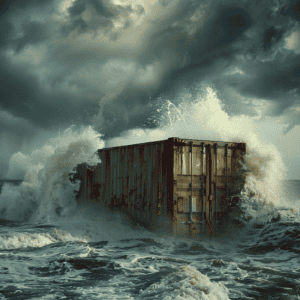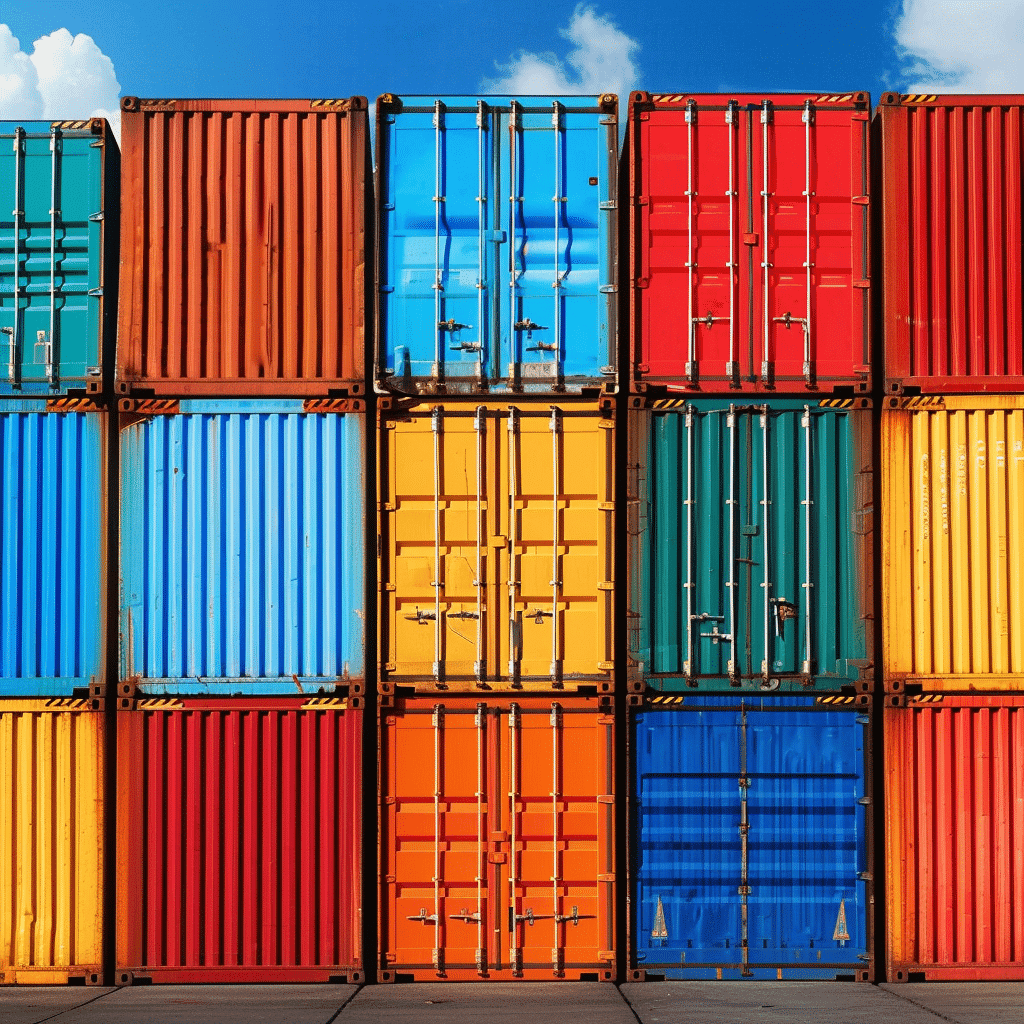Imagine you’re in a shipping container home, a hurricane is barreling towards you. You’re asking yourself, ‘Can this steel box withstand Mother Nature’s fury?’
The answer is yes. When properly secured to a foundation, these shipping containers can handle wind hurricanes and wind speeds even higher, with some sources indicating they can withstand up to 130 mph when unsecured and up to 175 mph if properly anchored.
In this article, we’ll dissect the resilience of these containers against such violent storms. We’re diving into wind resistance, anchoring, protective measures, and what building codes say.
The Increasing Use of Shipping Containers
Why are more and more people choosing to use shipping containers as homes and businesses these days?
You might be surprised to learn it’s not just about cost-efficiency. Shipping container homes, often referred to as container houses, offer a unique blend of practicality and innovation. They’re sturdy, adaptable, and provide a quick solution for housing needs. As a result, container living is gaining momentum worldwide.
From a single container transformed into a cozy tiny home to multiple units combined to create an impressive commercial space, the possibilities are endless. Plus, the fact that a shipping container home can potentially withstand severe weather conditions, like hurricanes, adds to their appeal. It’s no wonder people are embracing this trend!
The Inherent Strength of Shipping Containers
You mightn’t realize it, but shipping containers are inherently strong due to their original purpose of withstanding the harsh marine environments they’re exposed to during transport. These steel cargo containers are built to withstand hurricanes and other harsh weather conditions when they are stacked on container ships, thanks to their impressive structural strength.
They’re constructed from weathering steel, known for its ability to resist corrosion. This makes them resilient in the face of salty seawater, intense winds, and harsh sunlight.
Hurricanes and Their Impact
While it’s clear that shipping containers are sturdy, when a hurricane strikes, your safety is paramount and understanding the power of these storms is crucial. Hurricanes and their impact can be devastating.
With hurricane force winds reaching up to 157 mph or higher, even the most robust structures can crumble. These extreme weather conditions can catapult a shipping container, regardless of its strength.
The extensive damage category associated with hurricanes outlines the severity of these storms. They can wreak havoc, flattening entire towns, and causing extraordinary damage.

Shipping Containers in the Face of Hurricanes
In the face of a hurricane, your shipping container’s resilience heavily depends on its preparation and location, among other factors. You may wonder, can a shipping container withstand a hurricane? The answer isn’t straightforward.
Shipping containers can withstand hurricanes, but their ability to do so relies on factors such as anchoring and location. They’re designed to resist high winds, a must-have in hurricane prone areas. However, if they’re not properly secured, they can be swept away.
When considering shipping container homes, it’s crucial to have them anchored to a solid foundation. This way, even if a hurricane strikes, your home stands a better chance against the destructive forces of nature.
Wind Resistance Capabilities of Shipping Containers
Given that they’re designed to withstand high winds, it’s clear that shipping containers have impressive wind resistance capabilities. Their sturdy steel structure can hold up against a significant wind load, making them potentially hurricane-proof.
The aerodynamic shape of the container further enhances its wind resistance, ensuring it stays grounded even in a storm.
You might be wondering, ‘Can container homes withstand hurricanes?’ Well, the answer lies in the construction. If properly anchored and reinforced, these homes can indeed withstand high winds. However, it’s important to remember that while containers are robust, they’re not infallible. Therefore, taking additional precautions during hurricanes is always wise.
The Role of Modifications and Reinforcements
You can’t just rely on a shipping container’s inherent strength when it comes to hurricanes; you also need to consider modifications and reinforcements.
Reinforcements strengthen the structure, ensuring it can withstand the fierce winds and heavy rainfall of a hurricane. Consider adding steel bars or wooden beams to enhance the container’s rigidity.
Modifications, on the other hand, can include weatherproofing and installing hurricane-resistant windows and doors.
Remember, the goal with these modifications and reinforcements is to enhance the shipping container’s ability to withstand a hurricane. It’s not about making it indestructible, but about making it resilient enough to protect what’s inside during the storm.
Foundation and Anchoring
Beyond modifications and reinforcements, your shipping container’s foundation and anchoring play a critical role in its ability to weather a hurricane. The foundation and anchoring provide stability and prevent the container from being swept away by strong winds.
Proper anchoring is crucial, and this involves securing the container properly to its foundation using tie downs. Building codes often stipulate the requirements for these tie downs, so it’s essential you adhere to them.
Besides ensuring your container is secured properly, it’s also key to choose a suitable foundation. A concrete slab is a popular choice due to its strength and stability.

Additional Protective Measures
In addition to securing your container to a sturdy foundation, there are several other protective measures you can take to further enhance its hurricane resistance.
If you’re in a hurricane prone area, adhere strictly to local building codes; they’re designed to protect structures against such events.
Reinforce your container with additional bracing and supports, particularly in its corners and edges where it’s most vulnerable.
Consider installing storm shutters or protective screens over windows to safeguard against flying debris.
Use hurricane straps to secure the roof and walls to the foundation.
Protecting your shipping container from a hurricane isn’t just about securing it to the ground, but also about reinforcing its structure and following local building guidelines.
Building Codes and Regulations
Adhering to the local building codes and regulations is a crucial step you can’t afford to skip when preparing your shipping container for a hurricane. These guidelines ensure that your container structure is built to withstand severe weather conditions.
When constructing your shipping containers based dwelling, it’s essential to consult with a local building inspector or professional builder. They’ll guide you on the necessary steps to comply with the codes, which may include engineering the foundation, securing the container, or reinforcing structural points.
Frequently Asked Questions
How much wind can a shipping container withstand?
Shipping containers are designed to endure the harsh conditions of sea travel, which includes withstanding winds of up to 100 mph and waves that can reach 50 feet in height. When properly secured to a foundation, these containers can handle wind speeds even higher, with some sources indicating they can withstand up to 130 mph when unsecured and up to 175 mph if properly anchored.
This robustness makes shipping containers not only suitable for maritime transport but also as potential storm shelters, offering protection against high winds and flying debris. According to rigidity test standards, a shipping container can withstand wind speeds of up to 180 mph if anchored, showcasing their capability to serve as durable structures even in extreme weather conditions.
Can a hurricane lift a shipping container?
An anchored shipping container is capable of withstanding wind speeds up to 180 mph without being moved, indicating that it would require the extreme force of a Category 5 hurricane or an F3+ tornado to potentially lift or shift a shipping container.
This resilience underscores the structural integrity of shipping containers, making them highly resistant to even the most severe weather conditions when properly secured. Their ability to endure such high wind speeds without budging highlights their suitability for use in areas prone to hurricanes, provided they are anchored correctly to prevent displacement.
Is a shipping container a good storm shelter?
Shipping containers have increasingly been recognized as a viable option for storm shelters due to their sturdy steel construction, which is designed to withstand harsh elements and carry thousands of pounds of cargo. Their durability and strength make them capable of enduring severe weather conditions, making them a strong and durable choice for storm protection.
With proper reinforcement and secure anchoring, shipping containers can be transformed into robust storm shelters, offering a safe haven during hurricanes or tornadoes. This adaptability, combined with their portability, positions steel shipping containers as an ideal foundation for constructing storm shelters, contributing significantly to disaster management efforts.
How do you make a shipping container hurricane proof?
To make a shipping container hurricane-proof, it is essential to reinforce the walls and roofs, add additional bracing for increased structural integrity, and securely anchor the container to a solid foundation, such as a concrete slab or pilings.
These measures ensure the container remains stable and intact during a hurricane, providing a safe and durable shelter against the storm’s powerful winds and potential debris. By carefully considering these modifications and reinforcements, shipping containers can be transformed into storm-safe homes capable of withstanding the severe conditions brought on by hurricanes.
Conclusion
After all is said and done, you’ve got to understand that a shipping container’s ability to withstand a hurricane largely depends on how well you’ve prepared and fortified it. This conclusion isn’t drawn lightly as significant damage can occur if proper measures aren’t taken.
For a shipping container to withstand a hurricane, it’s crucial to consider its placement, anchorage, and structural integrity. A well-anchored container in a strategic location can withstand strong winds and resist water damage. Moreover, reinforcing it can significantly improve its resistance.


